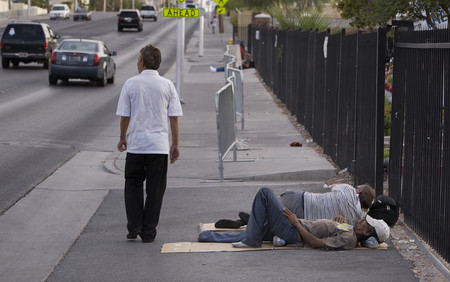‘Invisible population’ coming and going
The tents are gone. The streets in downtown's homeless corridor are clean. The homeless have moved into housing or simply moved along.
But not all of them.
"They are back in droves. It's a mess," Sue Markham, director of homeless services for the local Salvation Army, said last week.
Markham estimated that 75 destitute campers, who left the corridor in recent weeks after an intensive intervention by police, social service workers, city officials and others, are returning each night to sleep in the area.
Instead of clustering in tents pitched on the sidewalks, as before, the campers sleep in the open along A Street, near the railroad overpass or inside an old trailer park in the area around Main Street and Owens Avenue known as the homeless corridor.
They disappear early each morning and return at night, knowing they're not wanted.
"They know how to make themselves scarce," said Linda Lera-Randle El, director of the Straight from the Streets homeless outreach program. "They're not called the invisible population for nothing."
In recent weeks, members of the "Corridor of Hope Alliance," citing crime, sanitation and accessibility issues, helped disband the tent city populated by hundreds that had sprung up in the neighborhood.
Sidewalks were lined with metal barriers preventing people from pitching tents.
The alliance touted the operation as a success, saying scores of homeless people were placed in housing or given bus tickets home.
Few dispute that good came of the outreach efforts. People who had no place to go now have homes.
"We were able to bring women in, and we made huge strides with them, that we never would have made" without the intervention, said Marlene Richter, executive director of the Shade Tree shelter for women and children.
"It feels like we accomplished something," Richter said.
But, "let's be honest," Markham said. "There will always be homeless people who don't want our services. What happens when we move homeless people who aren't ready to move is displacement."
"They scatter when you do things this way," Lera-Randle El said. "That doesn't mean some of them weren't helped. I'm not discounting the effort."
One problem is the large number of homeless people who don't fit into any particular program. They may have multiple addictions and severe mental health issues, be disabled, sick, unable to work for a variety of reasons, or all of the above.
"Their issues take on tentacles," Lera-Randle El said.
Since outreach efforts began in late May, about 1,500 people in the corridor have been referred to different services for help, according to Annie Wilson, liaison to the homeless for the Metropolitan Police Department.
Some of those may be duplicate referrals, because "with the homeless sometimes you have to talk to them five or six times before they accept help," Wilson said.
"What you can't do is give up."
It's difficult to come up with a comprehensive number of homeless people who got off the streets during the recent intervention because so many agencies were involved.
The alliance also plans to continue its efforts.
Richter said her agency managed to convince nine women to come into a shelter for help.
The city of Las Vegas said 100 people were referred to its transitional housing program during outreach, and 34 people were given bus tickets home.
HELP of Southern Nevada said it moved 20 people from the homeless corridor into their program, which includes intensive case management.
One of those who was living in the corridor was 50-year-old Timothy, who asked that his last name not be used.
After nearly two decades on Las Vegas' streets, he was ready to finally kick drugs and accept help, he said.
"You're out there with nothing, no resources, wearing the same clothes for a month. People are out there for years. They got no place to go."
Timothy, who suffers from diabetes, depression and severe arthritis, hasn't worked since 2007 and was denied disability benefits.
Straight from the Streets set him up in an apartment.
Case managers make sure he keeps his doctor's appointments and goes to recovery meetings. They also give him regular drug tests.
He understands all too well the hazards of life on the street.
Once, a man beat Timothy with a tire iron while he was camping in the homeless corridor.
Another time, a man drove through the corridor, shooting homeless people with a paintball gun through the open window of his car.
"You just try not to get in trouble," Timothy said. "All you got is your own two feet, and they are in agony from being on the street."
Contact reporter Lynnette Curtis at lcurtis @reviewjournal.com or 702-383-0285.




























